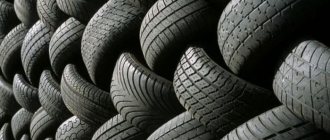The shelf life of fire extinguishers of all types is not the same, and is primarily established by the manufacturer based on the airbag. Each fire extinguisher has a certificate of compliance with fire safety standards.
The time frame for maintenance, operation, and warranty is indicated in the technical documentation of the fire extinguishing device. The NPB establishes certain minimums, which can be adjusted by the manufacturer for specific models based on specifications, technical justification, developed, approved and in compliance with the law.
Purpose of fire extinguishers
Fire extinguishers are the primary fire extinguishing means. Their presence is necessary along with fire shields and hydrants.
The conditions for storing and operating devices are regulated by law. Large mobile devices are located in fire and explosion hazardous facilities, while manual ones are used everywhere. The smallest hand-held devices have firmly established themselves as “car” fire extinguishers.
Fire extinguishers
Purpose of devices:
- reducing the fire hazard of the premises;
- fighting the fire until firefighters arrive;
- fire extinguishing or localization;
- saving human lives and property.
What is the fine for an expired fire extinguisher?
Fines for violation of the NPB are provided for individual entrepreneurs, legal entities, including government agencies and public organizations. The GPS punishes the manager or person responsible for the facility. Fine amount:
- for individual entrepreneurs: 20,000 – 40,000 rubles;
- for legal entities persons: 150,000 – 200,000 rub.
Failure to correct the violation within 90 days. threatens to suspend the activities of the enterprise.
The traffic police inspector has the right to check the presence of a working fire extinguisher only when inspecting the car. The procedure is complex and is not used often (it requires good reasons). The fine will be 500 rubles. (Article 12.5 of the Administrative Code), but a citizen has the right to demand a warning. We must remember that it is impossible to complete the maintenance without a working fire extinguishing agent.
Types and shelf life of each
There are many models of fire extinguishers on the market. The most modern of them are stationary modular devices designed for one-time use. However, most devices are recharged and used for a long time.
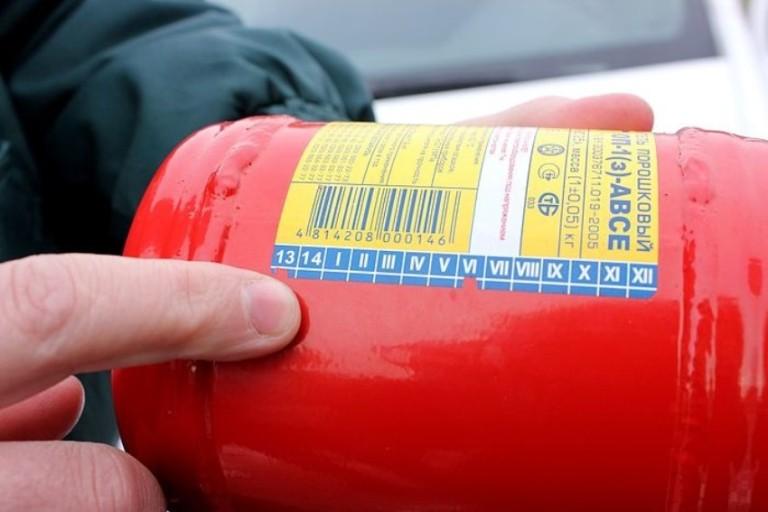
Fire extinguisher expiration date on the label
The average lifespan of a rechargeable fire extinguisher with a metal body is determined to be 10 years. After this period has expired, there are three ways to use the device:
- Regeneration. A multi-stage examination procedure that allows you to check the further performance of the device.
- To conduct exercises. This is only possible if the equipment remains operational.
- Recycling. It involves disassembling the device and disposing of its parts for scrap.
On a note. The service life of fire extinguishers depends on the fire extinguishing agent (FMA) used, each of which has its own characteristics.
Carbon dioxide
Serve for at least 10 years. They often “outlive” their standard period, especially during scheduled maintenance and proper storage.
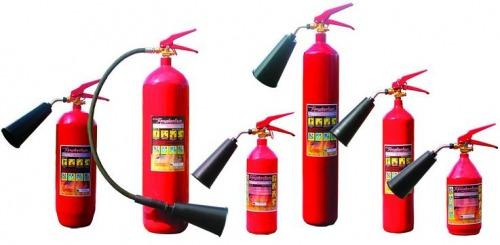
Carbon dioxide fire extinguishers
Freon
The operating period is the same as that of a carbon dioxide device due to the similarity of the substance - both devices use liquefied gas. When carrying out maintenance, it is recommended to check the cylinder for tightness and perform scheduled weighing. On average, the service life of a halon fire extinguisher is 10 years or more.
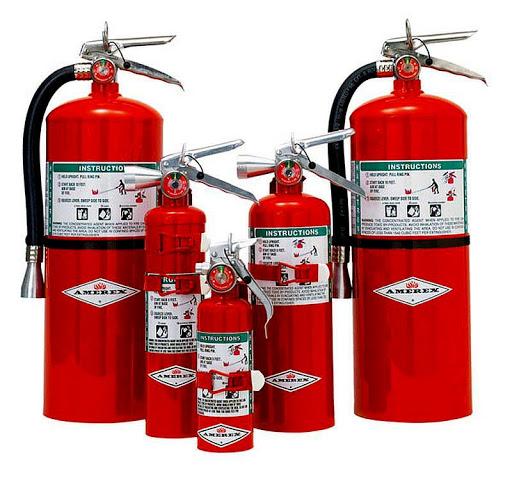
Freon fire extinguishers
Foam
Despite the standard period of 10 years, foam and air-foam devices rarely “live” to this “age”. The reason for this is the water base of the substance. Moisture causes rust and metal deterioration. The service life largely depends on the storage temperature.
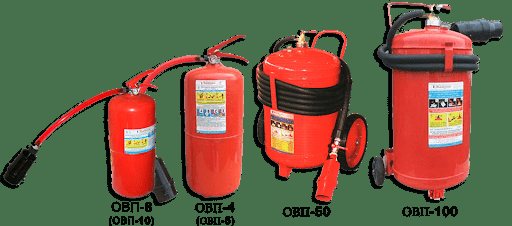
Air foam fire extinguishers
Powder
The most common type of devices in the Russian Federation. The type of powder composition does not affect the wear of the device - fire extinguishers last at least 10 years, and if storage and operation standards are observed, more.
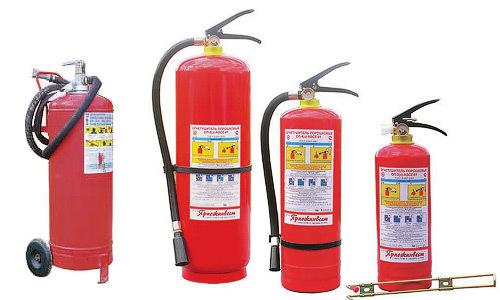
Powder fire extinguishers
Water
The most narrowly targeted and “fastidious” type of device. The service life of such a fire extinguisher is usually less than 10 years. Water has several negative features:
- provokes metal corrosion;
- deforms parts when frozen.
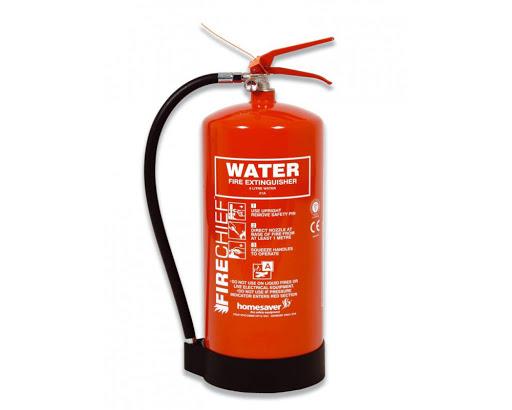
Water fire extinguisher
Regulatory documents on deadlines
The shelf life of any type of fire extinguisher is determined and checked in accordance with regulatory documents, which are guidelines both for the manufacturers of this product and for specialized offices that are directly involved in the maintenance of fire extinguishing equipment.
Regulatory documents in the field of checking the service life of fire extinguishers are:
- SP 9.13130.2009 on requirements for the operation of fire extinguishing devices.
- NPB 166-97. Regulates the use of all types of fire extinguishers.
- GOST 51057-2001 and GOST R 51017-2009. The requirements and routine testing of hand-held and mobile fire extinguishers are outlined.
How to find the expiration date on a fire extinguisher
Question “How to determine the expiration date of a fire extinguisher?” has several answer options:
- The information is indicated in the device passport. The document indicates not only the date of manufacture, but also the standard period of operation.
- You can see the release date on the label affixed to the body of the fire extinguisher. Typically, two scales are drawn on the cylinder: with Roman (months) and Arabic (year) numerals. There are notches on each scale indicating the approximate production time.
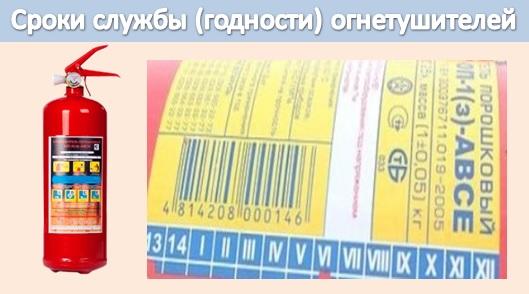
Service life symbol on the fire extinguisher
How to determine
It is possible to independently determine the suitability of a fire extinguisher. First, look at the pressure gauge, the arrow should be in the green zone - this means that the cylinder is at pressure and can be used. In red, this is recharging, even if the service period has not expired.
A visual inspection reveals the integrity of the housing. It is also worth paying attention to the conditions under which the device is kept. If it is exposed to direct sunlight, the contents may have become unusable.
Then you need to inspect the markings. Date of manufacture (see factory sticker), 2 holes punched out (year and month). Depending on the content, the number of years that the device will last will vary from 1 to 10. The date of manufacture and permissible service life are marked. The remaining period is easy to calculate based on these values.
Is it possible to use expired
The use of expired devices is permitted only after a special check - a regeneration procedure. Without testing, operating a fire extinguisher whose useful life has not been extended is fraught with the following consequences:
- Danger to the lives of people in the room. At best, the device will not work at a critical moment. At worst, the cylinder will explode right in the hands of the person who pulled the trigger.
- Fines. If an expired device is found during an inspection at an enterprise, the organization faces a fine of 20,000 to 200,000 rubles.
- Damage to property. If the primary extinguishing means do not work, then people at the site are required to leave the premises and wait for the fire brigade to arrive. During this time, the flame intensifies, increasingly damaging the building and everything in it.
- Prohibition of activities. In the event of particularly large fire safety violations, the fire department suspends or prohibits the continuation of work in the building.
Attention! Using an expired device in a business or at home is unreasonably dangerous.
What to do with an expired fire extinguisher
It is recommended to dispose of products that have exhausted their temporary service life, especially carbon dioxide, freon, aerosol, and also those with environmentally unsafe wastewater.
Individuals do not face liability for storing an expired fire extinguisher. But at enterprises, devices must be written off and handed over to specialized companies for disposal, carried out in two ways:
- processing, destruction, use for other purposes;
- regeneration – renewal of properties (typical for OX, OU).
How to extend the validity period
Extending the life of a fire extinguisher is called a rehabilitation procedure. It applies to devices that are in good condition after the expiration date. The process is divided into several steps:
- from all remaining devices, four charged ones are selected;
- all the charge is released from the devices without any residue;
- the case is opened, recharged and hermetically sealed;
- the substance is completely released again.
The cycle of actions is performed eight times, measuring the pressure in the cylinder and the jet length during the process. If the fire extinguisher does not malfunction, then it is put into further operation.
The test is characterized by its complexity and consumption of substances, so not all devices are allowed for the procedure. The most common reasons for refusal of verification are:
- mechanical damage to parts;
- cases of device malfunction;
- corrosion – both on the external parts of the device and on the internal ones;
- untimely inspection and recharging.
The shelf life of a fire extinguisher can only be extended if the device is properly stored and used correctly. There are several recommendations for maintaining the functionality of the device:
- Protect the fire extinguisher from mechanical damage. It should only be stored in special stands or brackets.
- Protect the body and parts from exposure to aggressive factors.
- Maintain optimal storage temperature (indicated in the product data sheet).
- Recharge the device and carry out maintenance according to the schedule.
Which one will fit in the car for technical inspection?
For people whose occupation is not related to fire safety, the most pressing issue is the availability of a fire extinguisher. Without it you will not be able to pass the inspection.
For car/truck/minibus
A powder or carbon dioxide fire extinguisher with 2-3 liters of active substance, OP-2, 3 or OU-1, 2, 3, is suitable for a car. The metal case is more reliable. For a cargo vehicle you will need a more significant volume - OU-5.
The powder one has excellent pressure, it is compact and inexpensive, the only drawback is that it leaves contamination.
Gas, on the contrary, evaporates, but is toxic. Therefore, it is recommended to use gloves when spraying.
ADVICE! When purchasing, be sure to pay attention to the integrity of the seal and the end of use.
Best before date:
- OP: 10 years for the cylinder, 2 for the powder;
- OU: 10 years per cylinder, 5 years per charge.
Where is the best place to store
The device must be carried in the car, fixed on a bracket. A good option is the passenger door. With this arrangement, the fire extinguisher will not interfere with the driver; at the right time it is easy to reach and use it.
Why can't it be placed in the trunk?
From experience, it can be said that access to the device in the luggage compartment can be difficult, although the rules do not regulate its location.
Indeed, it is not recommended to store fire extinguishing agents in the trunk. This is detrimental to any mixture. The device will have to be recharged annually to ensure the safety of passengers.
Is an expired vehicle eligible for technical inspection?
An expired fire extinguisher will not be suitable for technical inspection. It does not guarantee the safety of the car owner, which means it does not meet the requirements. Such rules exist to preserve the life and health of the driver and his passengers, so the owner must understand the importance of the current charge period.
Rules for disposal of expired devices
All standards for the disposal of fire extinguishers are established by law. Simply taking the expired device to the trash and pouring the charge down the drain will not work - large fines are provided for such actions. Each device must be disassembled into parts and disposed of as scrap metal, and the remaining substances must be disposed of in a special company.
The entire parsing process is divided into several steps:
- Relieving pressure from the cylinder. For low-pressure fire extinguishers (operating indicator below 2.5 MPa), the indicator is reduced to 0. In the case of high-pressure apparatus (more than 2.5 MPa), the discharge is carried out gradually. The values are measured with a pressure gauge. It is recommended to maintain a distance of 1 meter between the worker and the device.
- Removing additional parts. Depending on the model, these can be hoses, carts, sockets, nozzles and mixers.
- Dismantling the shut-off and release device with a siphon tube. If the device operates under high pressure, then the disconnection is carried out in parallel with a gradual decrease in pressure.
- Drain off the remaining substance. The general rule is to collect the product in an airtight container.
- Rendering the cylinder unusable. The most common methods: sawing off threads, drilling a hole, cutting a container on a machine. In some cases, further use of the cylinder is possible - then it is left intact.
Substances are disposed of in different ways. A few examples:
- The powder composition is handed over for recycling. Typically, the residues are either burned in a landfill or used as a base for fertilizers due to their high nitrogen content.
- Carbon dioxide is disposed of as a chemical in a special company.
- Water from the fire extinguisher is poured into the drain.
- Disposal of foaming agent depends on its type: “soft” substances are brought to the level of household chemicals and poured into the sewer, “hard” substances are burned.
Checking and refilling times
The frequency of maintenance and recharging is determined by several factors:
- fire extinguishing agent;
- apparatus design;
- scope of application of the device.
The rules for replacing the squad determine the following terms:
- once every 5 years for powder and gas devices;
- once a year for fire extinguishers using water or its derivatives (foam, emulsion);
- after each use of the device.
Recharge times change when used in more aggressive conditions, for example, in transport. Powder devices are recharged once a year, carbon dioxide and aerosol devices - once every two years.
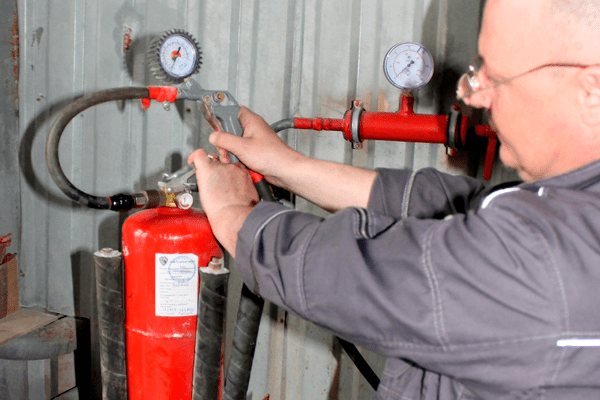
Fire extinguisher recharging process
Maintenance is carried out once a year. Most often it includes the following procedures:
- Visual inspection for mechanical damage, corrosion, and rust.
- Measuring the pressure in the cylinder.
- Weighing. Carried out for carbon dioxide and refrigerant devices. Liquefied gas in such fire extinguishers can evaporate and leave unsealed containers. Annual weight loss should not exceed 5% of the charge weight.
Some fire extinguishers undergo a more extensive inspection every 5 years, together with a scheduled recharge.
- external and internal inspection of the device for rust, corrosion and mechanical damage;
- checking the elasticity of membranes and gaskets of the device;
- testing the performance of the locking mechanism and pressure gauge.
All defects found during testing must be eliminated as soon as possible. The results of all checks are entered into the device passport.
Requirements for a car fire extinguisher
The Code of Fire Safety Rules strictly states that in order to pass the technical inspection, you will need a car fire extinguisher with a volume of at least 2 liters. The same document does not say in which body it should be presented. But it is better to give preference to metal.
- In this case, the fire extinguishing device must have a passport and a certificate of origin.
- If it has not yet been used, then its receipt must be sealed.
- Of course, the unit itself must be in technically acceptable condition, and the service life of the car fire extinguisher must not be expired.
If all these conditions are met, then the inspector will not be able to find fault with fire safety requirements.

Seal on the check
conclusions
The nominal service life of rechargeable devices is 10 years. In reality, how long a fire extinguisher will last depends on several characteristics:
- fire extinguishing agent used;
- conditions of storage and use;
- timely maintenance and recharging.
After the expiration date of the device, it can be sent for a rehabilitation procedure, after which the device is used further. To be allowed into the procedure, the fire extinguisher must be in good working order.
Marking
Each fire extinguisher has markings from which you can find out information about the device. The first letters characterize the composition of the stewing mixture:
- OV - aquatic;
- OVE - air emulsion with a fluorine-containing charge;
- ORP - air-foam;
- OP - powder;
- OC - carbon dioxide;
- OX - refrigerant.
The next number indicates the volume of the fire extinguishing agent (for example, OP-3 contains 3 liters of powder). The letters Z, B, G will tell you about the principle of creating pressure in the body.
Latin letters A, B, C, D, E indicate the fire class. After them is the model designation (01, 02). There is information about the manufacturer and operating pressure.
The label also provides brief instructions regarding recharging (immediately after use), inspection and testing intervals. Notes are made about each of the events.
Below is one of the main characteristics - the date of manufacture of the fire extinguisher and its expiration date.




